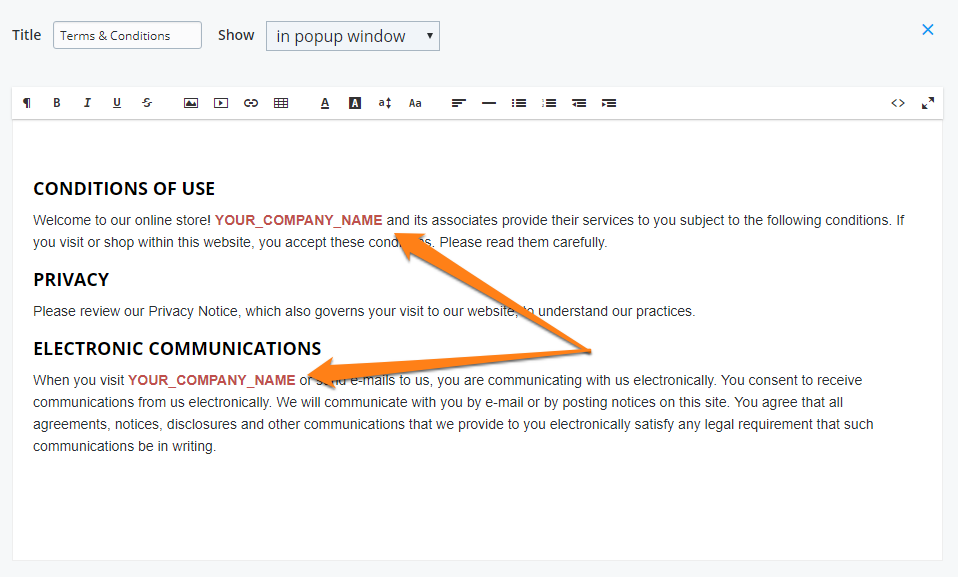だけについて 千人に一人 ウェブサイト訪問者の が T&C ページを参照します。
「小規模なオンラインビジネスなので、どうせ誰も読まないのなら、この退屈な法的文書を書く手間を省くことができるだろうか?」と、当然疑問に思うかもしれません。
必須ではありませんが、ストアの「利用規約」は、サイト上で最も重要なページの 1 つである可能性があります。利用規約には、ユーザーが Web サイトを使用するために従わなければならないすべてのルールが記載されています。これらのルールは、紛争が発生した場合に、あなた、あなたのビジネス、そしてあなたの顧客を保護するために作成されています。
ウェブサイトの利用規約ページには具体的に何を含めるべきですか? また、どのように作成すればよいですか? 質問しづらい質問にはすべてお答えします。
ウェブサイトの利用規約ページとは何ですか?
ウェブサイトの利用規約(別名「サービス規約」または「使用条件」)は、ウェブサイトとそのユーザーとの間の法的契約です。ウェブサイトの責任を定義し、ユーザーに権利と制限事項を通知します。
通常、このページは法的拘束力を持ち、法廷で紛争を解決するために使用できます。このページには、Web サイトの所有者と管轄区域が記載されています。また、Web サイトの責任、賠償責任、商標、著作権も記載されており、法的手段を求めて企業に連絡する方法をユーザーに通知しています。
この文書は必要に応じて拡張できます。大規模な Web サイトには、そのビジネスとのやり取りのあらゆる側面を定義する条項が数十個あることがよくあります。たとえば、Amazon の利用規約ページは約 3,500 語の長さで、著作権侵害から召喚状の送達方法の説明まで、あらゆる内容が網羅されています。
ウェブサイトに利用規約が必要なのはなぜですか?
通常、プライバシー ポリシー ページを含めることは法律で義務付けられていますが、サイトに利用規約ページを含めることは法律で義務付けられていないことがよくあります。責任や顧客の制限事項をまったく認識せずにビジネスを運営することは簡単です。
顧客が訴訟を起こしたり、アカウントを悪用したり、著作権を侵害したりした場合に問題が発生します。利用規約を明確に示さなければ、紛争が発生した場合に法的手段を講じることができない可能性があります。
これは、あなたのサイトにアクセスするすべての人が自動的に同意する契約だと考えてください。紛争が発生した場合、裁判所はこの契約を参照してあなたの権利と責任を決定します。
これは、法的に強固な利用規約を持つことが重要である理由でもあります。法廷でも通用する内容が求められます。
「利用規約」と「プライバシーポリシー」の違いは何ですか?
ウェブサイトの一番下までスクロールしたことがあるなら、「利用規約」、「プライバシーポリシー」などの法的ページへのリンクがいくつかあることに気づいたかもしれません。
たとえば、Gap.com のフッターには、同社の法的業務の主要な側面が記載されています。

中でも最も重要なのは、「利用規約」と「プライバシーポリシー」のページです。似ているように聞こえるかもしれませんが、法的に言えば、カバーする領域はまったく異なります。
プライバシーポリシー:
- 電子メール、電話番号、位置情報などの顧客の個人データを収集および処理するプロセスをカバーします。
- これは通常、あらゆる種類の顧客データを収集するウェブサイトに対して法律で義務付けられています。何らかのトラッキングコードやクッキー( Google Analytics コードを使用する場合は、プライバシー ポリシーが必要になります。
対照的に、利用規約ページは通常、法律で義務付けられていません。紛争が発生した場合に自分自身を保護するためだけに作成します。
ほとんどのウェブサイトでは、プライバシーポリシーと利用規約のページは独立しています。
ウェブサイトの利用規約ページには何を含めるべきですか?
大まかに言えば、利用規約ページは次の 4 つの目的を果たすことを目的としています。
- ビジネスのオーナーを特定し、連絡方法を知る
- サイトで使用されているコンテンツ、著作権、商標の所有者を特定する
- 企業の負債と責任を特定する
- ユーザーによる不正使用があった場合に備えて、法的手段を講じられるようにしてください。
技術的にはこのページに何でも含めることができますが (法的に許可されている限り)、上記の 4 つの領域に重点を置くことをお勧めします。
したがって、ほとんどのウェブサイトの利用規約には次のセクションが含まれます。
- ウェブサイトおよびストアページで提供される資料の著作権および商標
- サイト、コンテンツ、および関連する商標の所有権
- ストアの利用要件(登録が必要かどうかなど)
- ユーザーがサイトにアクセスする方法の制限(たとえば、データの収集やコンテンツのコピーができない)
- 誰が所有しているか
ユーザー生成 レビュー、コメントなどのコンテンツ - 配送中の紛失、商品の説明が不正確であった場合などの責任。
- 紛争が発生した場合の管轄地域(国および州)
- その他のポリシー(配送や返金ポリシーなど)および連絡先情報へのリンク。
もちろん、これを超えることもできます (Amazon には特許とアプリの許可に関するセクションがあります) が、ほとんどの企業にとって、紛争が発生した場合に保護するにはこれで十分でしょう。
ウェブサイトの利用規約ページを作成する方法
サイト上に法的ページを作成するときは必ず弁護士に相談する必要がありますが、利用規約ページは非常に一般的なので、少なくともほとんどの Web サイトでは、定型文を安全に使用できます。
Ecwidの顧客であれば、コントロールパネルにログインして、 設定 → 一般 → 法的情報 タブには何も表示されないことに注意してください。

「編集」をクリックするとコンテンツフォームが表示されます

完了したら、「保存」をクリックします。ページは自動的にウェブサイトの下部に追加されます。
このテンプレートはほとんどのビジネスに十分ですが、サイトの要件は異なる場合があることに注意してください。弁護士に相談して、ニーズを満たす利用規約文書を作成するのが最善です。
ウェブサイトのどこに利用規約を掲載すべきでしょうか?
利用規約ページは法的に重要ですが、Web サイトのユーザー エクスペリエンスにとって重要ではありません。ただし、顧客が簡単にアクセスできる必要があります。ページにアクセスできない場合、ユーザーは紛争が発生した場合に簡単に無知を装う可能性があります。
そのため、ほとんどの Web サイトでは、利用規約のリンクをフッターに配置しています。フッターはすべてのページに繰り返し表示されるため、ユーザーはいつでも必要なページにすぐにアクセスできます。
このリンクをフッターの「会社概要」または「会社情報」のヘッダーの下に配置することは珍しくありません。たとえば、Ecwid のフッターは次のとおりです。

Bonobos からの別の例を示します。プライバシー ポリシー リンクのすぐ隣に配置されていることにお気づきでしょうか?

ウェブサイトの利用規約について他に知っておくべきことは何ですか?
最後に、ウェブサイトの利用規約について知っておくべきことがいくつかあります。
- もしあなたが
eコマース ストアの場合は、プライバシー ポリシー、返金ポリシー、配送ポリシー、利用規約のページが別々に必要になります。 - 他の企業の利用規約をコピーすることはお勧めできません。その企業には非常に特殊な条件がある可能性があり、それがあなたのケースには当てはまらない可能性があります。
- 適切に書かれていない利用規約ページは、法的拘束力を持たない可能性があります。専門家が書いた定型文を使用するか、弁護士に相談するのが最善です。
- ビジネスやウェブサイトに変更があった場合は、利用規約ページが必ず更新されるようにしてください。
- ほとんどのオンライン テンプレートは、米国/英国の観点から書かれています。同じ法律があなたの国には適用されない可能性があります。そのような場合は、現地の弁護士に相談するのが最善です。
- ウェブサイトを英語以外の言語で提供している場合は、その言語でも利用規約ページを用意してください。
- 信じがたいことですが、一歩踏み出せば、面白くて魅力的な利用規約ページを作成できます。
最後に、そして最も重要なことですが、疑問がある場合は弁護士に相談してください。
あなたのウェブサイトには利用規約ページがありますか? ある場合、どのように作成しましたか? 以下のコメント欄でお知らせください。








